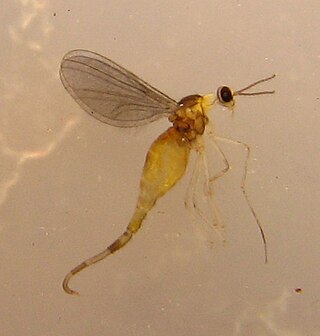
The Nematoceran family Axymyiidae is the sole member of the infraorder Axymyiomorpha, though it is often included within the infraorder Bibionomorpha in older classifications. It is known from only nine species in four genera, plus eight fossil species.
Polystepha is a genus of gall midges in the family Cecidomyiidae. There are more than 20 described species in Polystepha.
Catotricha is a genus of midges in the family Cecidomyiidae. The five described species in Catotricha are found in the holarctic region. This genus was established by British entomologist Frederick Wallace Edwards in 1938.
Resseliella is a genus of gall midges in the family Cecidomyiidae. There are at least 50 described species in Resseliella.
Monardia is a genus of wood midges, insects in the family Cecidomyiidae. The 53 described species in Monardia are grouped into three subgenera.
Micromyinae is a subfamily of wood midges, insects in the family Cecidomyiidae. Its members were formerly included in subfamily Lestremiinae. There are at least 55 genera and more than 650 described species in Micromyinae. All species in this subfamily are mycophageous.
Haplusia is a genus of gall midges and wood midges in the family Cecidomyiidae. There are more than 20 described species in Haplusia.

Winnertzia is a genus of gall midges and wood midges in the family Cecidomyiidae. There are more than 90 described species in Winnertzia.
Anarete is a genus of midges in the family Cecidomyiidae. There are 38 described species. The genus was established by Irish entomologist Alexander Henry Haliday in 1833 and has a cosmopolitan distribution.
Anaretella is a genus of midges in the family Cecidomyiidae. There are seven described species. The genus was established by German scientist Günther Enderlein in 1911 and has a cosmopolitan distribution.
Mangogrostix is a genus of midges in the family Cecidomyiidae. There are two described species in this genus. It was established by Russian entomologist Boris Mamaev in 1985.
Antennardia is a genus of midges in the family Cecidomyiidae. The four described species are found in the Holarctic realm. The genus was first described by Boris Mamaev in 1993, but was subsequently treated as a subgenus of Monardia until being reinstated at the genus level.
Bryomyia is a genus of midges in the family Cecidomyiidae. The six described species are found in the Holarctic and Oriental regions. The genus was first described by Jean-Jacques Kieffer in 1895.
Campylomyza is a genus of midges in the family Cecidomyiidae. The 40 described species are found in the Holarctic, Oriental, Neotropical, and Australasian regions. The genus was first described by German entomologist Johann Wilhelm Meigen in 1818.
Excrescentia is a genus of midges in the family Cecidomyiidae. There are two described species that are found in the Holarctic region.
Groveriella is a genus of wood midges, insects in the family Cecidomyiidae. The two described species are known only from Europe. The genus was established by Boris Mamaev in 1978.
Heterogenella is a genus of wood midges in the family Cecidomyiidae. The twelve described species are found in the Holarctic and Oriental realms. The genus was established by Boris Mamaev in 1963.
Neurolyga is a genus of wood midges, insects in the family Cecidomyiidae. The 28 described species occur in the holarctic region. The genus was established by Italian entomologist Camillo Rondani in 1840.
Skuhraviana is a genus of midges in the family Cecidomyiidae. The one described species - Skuhraviana triangulifera - is found in the Holarctic region. The genus was established in 1963 by Soviet entomologist Boris Mamaev.
Tropaprionus is a genus of wood midges, insects in the family Cecidomyiidae. There are seven described species in Tropaprionus.

